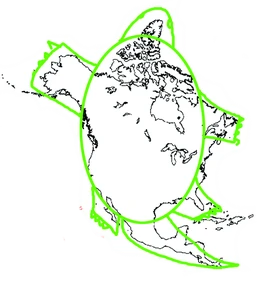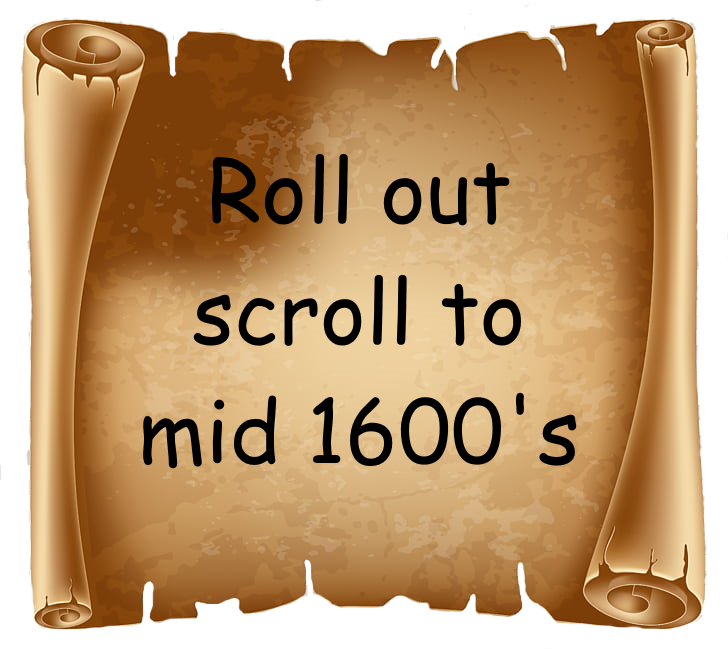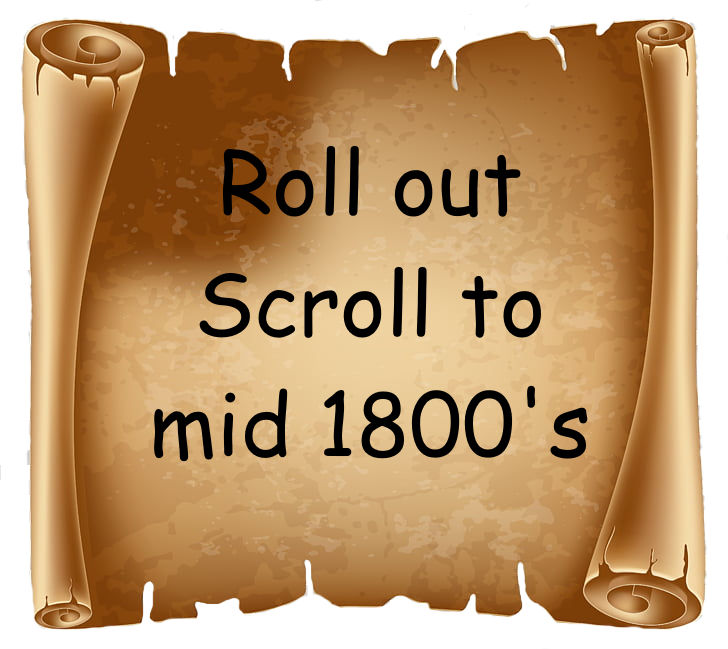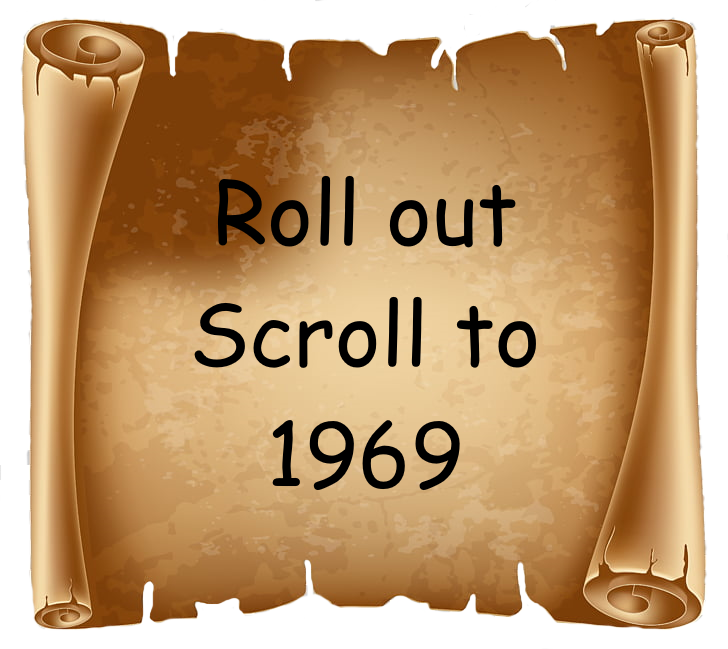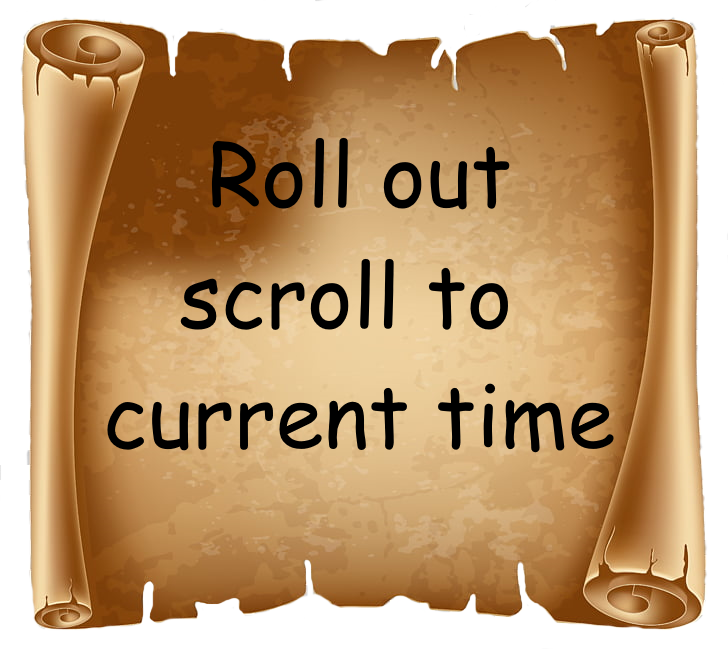7
Learning Objectives
It is critical to educate yourself on the Canadian narrative when working with Indigenous peoples. Shedding light on the dark Canadian history by probing the historical timeline of colonization, oppression, assimilation and cultural genocide.
- Probing historical timeline;
- Identifying key events and people; and
- Dissecting components of colonization and the impacts it caused.
Facilitator Tip:
- Remind participants of sensitivity of subjects and themes.
- Review the process when feel “triggered”.
- Throughout exercise, strengthen foundation of building layers of Anishinaabe Worldview.
- Highlight various definitions and concepts and allow time for discussion.
Journey of the Seed Activity
Activity adapted from SOADI’s Journey of the Seed, by Grandmother Rene Thomas Hill and from Edward Benton Banai’s Poem of the 7 Fires of Creation & Jim Dumont’s Reflection.
Original Instructions
Gitchie Manito moulded “a shape which contained the inspiration and the motivation to be. With intention and had within its blueprint the two side of twinness that makes up life itself. These are the ‘seed thoughts’ that hold the potential and essence of life.
Mother Earth
Gitchie Manito needed a place to send his seed thoughts with the essence of life. Aki, (Earth) was created, with “waters to flow in and around the earth, like veins and arteries carrying the life force of life itself.
Helpers of Mother Earth
We are of the Universe to bring about the harvest of all being – we are Sun, Moon, Wind, Water, Air, Animal and Seasons. Gitchie Manito sent seeds down from the Star World, they were brought by birds of every voice and every colour.
We, Indigenous People
We have been assigned to watch over and encourage the growth of these seeds and the continuation of them.
The Visitors
We bring our understandings of life, new flavors and technologies to your way of life. We bring our worldview of colonialism and greed to your instructions.
Changes of Values
People becoming less agricultural, moving away from the land to becoming urbanized.
Seed of No Spirit
I am no longer of spirit of our original Sacred Seed but am chemically inclined to create addiction of people so that there is nothing but chaos and death all about.
Grandmother Brings Hope
I have saved you for this new world. We have been waiting for you so that you can take these seeds and plant them as it was in the beginning. And what you are learning here is those seeds – taking those seeds, those sacred seeds, and now you are going to bring back that gift.
150 Years of Genocide
Today we will be learning about the Canadian narrative and the truth of Canada’s history. The one that many of us never learned in school. Today we will unpack events, legislation and oppression, assimilation and cultural genocide of colonization.
Remember your 4P’s: Perception, Power, Privilege and Purpose as we discuss some terminology, concepts and acts of Indigenous resistance.
Facilitator Tip:
- Ask participants to go back to some of the reflection questions from Day 1.
- Ask the questions below, give time for participants to reflect and invite people to share. Let participants know we will be learning more about these topics.
- Invite participants to share, or they can reflect throughout exercise and participate in the sharing circle.
Reflection Questions
- What does it mean to be Canadian?
- How do you benefit from colonization?
- What does reconciliation mean to you?
150+ Years of Genocide Activity
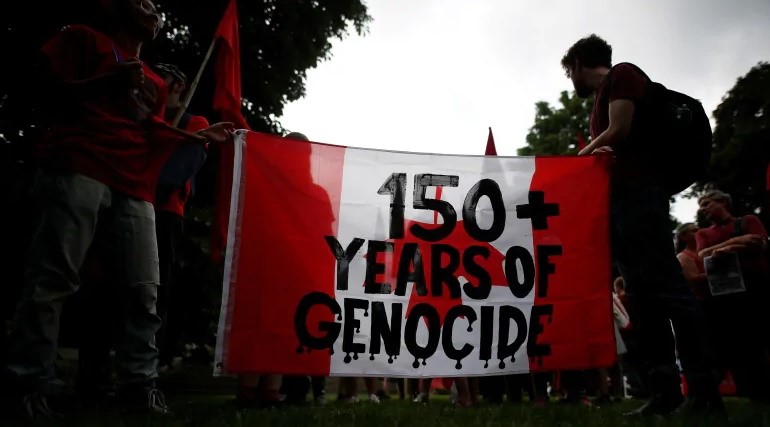
The intention of this question is to gauge the Participants and their knowledge of Indigenous resistance in the present climate. Have some examples prepared to discuss.
- Show the picture to the group, explaining where the photo was taken.
- Description: First Nations rights activists hold a banner reading “150+ Years of Genocide,” as they march following the “Unsettle Canada Day 150 Picnic,” in Toronto, Ontario, Canada, July 1, 2017.
- Ask the question, how does this photo make you feel?
- In 2017, Canada celebrated being a country for 150 years. Not everyone was celebrating.
- Some other examples from the last few years are:
-
- Robinson Huron Waawiindaamaagewin (Treaty) Annuities Lawsuit with Ontario government.[1]
- Idle No More “protest legislature that would erode Indigenous sovereignty and environmental protections—that has now changed the social and political landscape of Canada.”[2]
- “Unist’ot’en Camp to protect sovereign Wet’suwet’en territory from several proposed pipelines from the Tar Sands”[3]
- 1942 Land Back Lane[4]
- Mi’kmaq Fisheries [5]
5. Use the material below to further the discussion.
Senator Murry Sinclair, Commission Chairman illustrates why some people did not celebrate Canada’s 150, in his presentation of the Truth and Reconciliation report and the 94 Calls to Action in Ottawa, 2015. He addresses how Canada funded the Residential School System, which was in operation for over 100 years.
Question:
- What is meant by “it’s most vulnerable people?”
Bundle 7 Senator Murry Sinclair Statement on TRC Report
Indigenous Views on Canada 150_Agenda with Steve Paikin (28 mins)
Facilitator Tip:
- Opportunity to begin to discuss about healing. As an helper/ally, it is important to begin to educate yourself of the Canadian narrative, and truth underneath it.
- Healing begins with sharing our stories and being received. It is important to continue to create safe spaces for people to talk about “it” their healing.
- This space is about receiving, acknowledging and validating it.
Colonization Road Activity Overview
| Options | Explanation |
|---|---|
| Part I | Childhood Memories Slide Show In person
Virtual
|
| Part II | Introduction to Colonization Road Activity
|
| Part III | Time Immemorial
|
| Part IV | Colonization Road Bundle – face to face
|
| Part V | Reflection Questions – from Day 1
• What does it mean to be a Canadian citizen to you? |
Colonization Road Activity Script
Part I, Childhood Memories Slideshow
- Ensure PowerPoint of slide show of Cultural Program Events with children are playing in the background.
- If location has limited ability for slideshow, ask participants to look for a phone of a child in their life around 6-7 years old, put the picture next to them on their desk or on computer or phone.
- Adopted from Senator Murry Sinclair Presentation
Part II, Colonization Road Activity Introduction
The Colonization Road Activity is intended to be a journey through time that will explore historical events that are specific to North America and local to the North Shore of Lake Huron from Sault Ste. Marie to Sudbury. This historical storytelling will be from an Anishinaabe’s worldview, that is the First Peoples that were living on this land pre contact. The timeline is broken down into 5 main stages, 4 stages have been taken from The Royal Commission on Aboriginal Peoples (RCAP) and combined with the “Waves” from Jim Dumont’s the Story That Was Never Told. These stages are:
- Time Immemorial
- 1st Wave, Recon & Invasion
- 2nd Wave, Occupation
- 3rd Wave, Assimilation
- Resistance & Resiliency
Part III Time Immemorial – 12,000+ Years
Turtle Island Map – Poster Resource
There were 100’s of various nations of Indigenous peoples that lived in their territories across Turtle Island prior to settler arrival. This is known as “Separate Worlds”, Indigenous people living independently with a universal “understanding” of respect and humility that was grounded in connection with the spirit world.
- Identity location of the various First Nations and territories
- Terminology
- Treaties and understandings between Nations ex Dish with One Spoon
- Attention to the Bundle in the Center, review Day 1 & Day 2
- Ask participants to give some examples and symbolism.
The Royal Commission on Aboriginal Peoples identified this as “Stage 1 – Indigenous and non-Indigenous societies developed on their own in lands far from each other, with different cultures and forms of social organization. This changed when Europeans arrived and began to settle in North America.”
Review
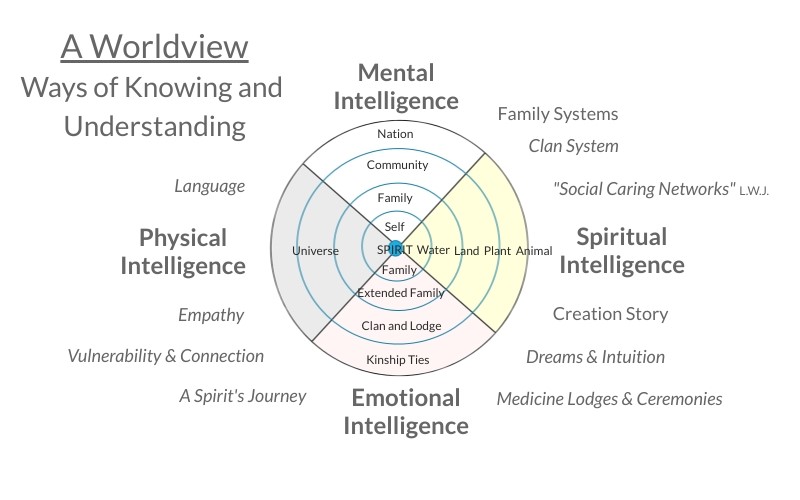
Treaties
Terminology Exercise
- Start with terminology to gauge the knowledge of the participants and decide if the terms need to be defined.
- Taking it step further, ask participants to give an example of their own experience of each term. (Can be done in smaller groups).
Terminology List
- Sovereignty – is the full right and power of a governing body over itself, without any interference from outside sources or bodies.
- Colonization – methods (behaviours, ideologies, institutions, policies and economies) that maintain the subjugation of exploitation of Indigenous Peoples, lands and resources.[6]
- Colonialism – the policy or practice of acquiring full or partial political control over another country, occupying it with settlers, and exploiting it economically.[7]
- Oppression – unjust or cruel exercise of authority or power
- Assimilation – to make someone or something become part of a group, country, society.[8]
- Genocide – defined by the 1948 United Nations (Geneva), intent to destroy, in whole or in part, a national, ethnical, racial or religious group, as such:[9]
- Killing members of the group;
- Causing serious bodily or mental harm to members of the group;
- Deliberately inflicting on the group conditions of life calculated to bring about its physical destruction in whole or in part;
- Imposing measures intended to prevent births within the group;
- Forcibly transferring children of the group to another group.
Intent to commit genocide could be inferred both from direct government actions, but also from its inaction when faced with the foreseeable implications of its policies.[10]
- Resistance – the refusal to accept or comply with something
- Treaties – International Law; an agreement or arrangement made by negotiation between sovereign nations
Leanne Betasamosake Simpson, Restoring Nationhood, speaks of treaties as political traditions; “both nations would thrive and be able to maintain pollical systems, cultures, languages and lifeways. Separate Nationhood jurisdictions would be respected, as would health and wellbeing of each other. Both would ensure health of the land and environment for future generations.”
Anishinabek Nation, We Are All Treaty People – Book (24 mins)
Part IV Colonization Bundle
Before Moving Forward
Before beginning where most people begin thinking about Turtle Island in “1492”. We need to back up the scroll to what life was like before contact. What was the history of the world before contact on Turtle Island? Specifically Europe, Brittan, Africa to name a few.
During this same time on turtle island, the people across the ocean in European countries have perfected the domination of peoples and lands by the strategic goals of genocidal warfare, pillaging (Pirates), slavery, and scorched earth policy in the name of Christianity and conquest.
It makes you thing what lead up to the Papal Bulls in the 1400s in Rome, which is what we know as the “Doctrine of Discovery”. Papal Bulls are formal statements from the Pope that decreed law. “During the European “Age of Discovery”, Christian explorers claimed lands for their monarchs who felt they could exploit the land, regardless of the original inhabitants.”[11]
This was invalidly based on the presumed racial superiority of European Christian peoples and was used to dehumanize, exploit and subjugate Indigenous Peoples and dispossess us of our most basic rights. This was the very foundation of genocide. Such ideology lead to the practices that continue through modern-day laws and policies.[12]
Examples of this established colonialist domination can be seen with:
- Ancient Egypt (Alexandria Library, 250 BC – what info was lost and effect to humanity)
- Roman Empire (at height 200 CE), where Roman Catholism came from
- Medieval Europe (750 CE), feudalism, separation rich from poor (power & privilege)
- British Empire (500 CE), majority converted to Christianity by 7th century[13]
- Later to Colonize (to name a few):
- North America (1600s)
- India (1750s)
- Australia (1780s)
- South Africa (1800s) – apartheid 1948-1996, New World as example
- Later to Colonize (to name a few):
1st WAVE – RECON & INVASION, 1497 to mid 1600s
Disruptions begin – Introduction, manipulation and brainwashing of worldviews.
Refer to the Turtle Island Poster, and the division of territories.
Indigenous people were skilled in the art of diplomacy, which included council, consultation and negotiation with other nations for millennia. In the Woodland area, there were customs and agreements between Indigenous Nations in the form of Treaty Wampum Belts, prior to settler arrival. An example is Dish with One Spoon Wampum Belt, which protected the shared territory from over hunting and overusing so that it would not be spoiled for everyone to use.
The Royal Commission on Aboriginal Peoples identified this time as:
Stage 2 – Contact and Co-operation (1500 to 1870) A growing non-Indigenous population sought ways to foster co-existence, mostly in the form of trading and military alliances. Despite a steep decline in Indigenous populations due to diseases carried by settlers, this time was marked by mutual tolerance and respect, with each society left to govern its own internal affairs.
However, in really this was a time of:
- Recon & Invasion that brought disease and genocidal warfare.
- During this time on other continents, people were mastering the skills of slavery and genocidal warfare techniques to conquer. Natural resources were diminishing, and the need to posses more, and lay claim to new lands became the focus of empires.
Reconnaissance: small expeditions to scout out new lands and resources and gather information. “These are often celebrated today as voyages of exploration & scientific discovery.” Example Jacques Cartier in the name of France, landing in 1534 on what is now Canada’s east coast looking for the North passage to Asia.[14] Cartier came with perception of authority under the Doctrine of Discovery.
Doctrine of Discovery: Created for European monarchies in 1400s by the Roman Catholic church (Terra nullius/Papal Bulls), declaring lands can be seized if not inhabited by Christians (Savages) in the name of discovery. This point is very important, the Church became very powerful and behind ALL colonial expansion, and is the root to ALL legal systems. “The New World” examples:
- Spain – Christopher Columbus, South America, 1492
- France – Jacques Cartier, Newfound Land, 1534
- Samuel Champlain, Quebec, 1603
- English – John Smith, New England, 1607
- Henry Hudson, Hudson Bay Basin, 1611
Invasion: can begin with a period of conflict of resistance to colonial forces. “Invasion can begin immediately after the recon or may be delayed by a period of trade & settlement that serve as a basis for later invasion. In every case, colonial military strategy is genocidal and includes the destruction of food supplies, resources & shelter, as well as massacres & biological warfare (disease).”[15] An example, Cartier kidnapped 2 Indigenous boys when he returned to England. He used them as guides when he returned to “the New World”, with more ships and men in 1535. Cartier kidnapped another bunch of Indigenous people his 2nd time back. This time, they never saw home again.
| 1534 | When the visitors arrived, they did not know the winters of North America. They were not prepared for survival. The Indigenous people showed them how to make medicine to help with scurvy, which was decimating them. The medicine was cedar tea. |
| 1603 | Samuel Champlain founded Montreal, Quebec on the grounds of the remains of an ancient Haudenosaunee village. He realized that in order to survive, he would need the help of the Indigenous people. There was no gold, jewels or other rich natural resources to make a profit. In the north, the main resource was furs, trees and fish. Champlain gained respect & trust of the Algonquin people that resided there, they became the first guides and fur traders.
Champlain also had something the Indigenous people had not seen before – industrialized items made from iron (combs, cooking utensils, pots, kettles and muskets). In exchange for the furs and the guidance into the interior, Champlain was asked to use the Musket against the Algonquin’s enemy, the Haudenosaunee (Iroquois). The musket changed life for the Indigenous Peoples of North America. This amplified the divide between the French and Algonquins and the English and the Haudenosaunee which would last for the next couple hundred years. |
| 1613 | It needs to be noted by 1613, The Two Row Wampum Belt was presented to the Dutch from the Haudenosaunee. This belt represents the 2 separate peoples traveling down the river in their own vessel, not interrupting or disturbing the other. The 2 purple rows symbolize brothers as equals, and the white symbolize friendship, peace and forever. |
| 1640 | Jesuits (French priests) came with these first explorers, they were apart of the settlements and missionaries. They made contact with Indigenous people and tried to sway the belief system to Catholicism. Over time, they made their way into the interior and across what is now the provinces. These tactics would be come more aggressive over time. By 1640, there is mention of Jesuits near what is now Spragge. |
| 1670 | Creation of the Hudson Bay Company in 1670, England’s King Charles II, claimed 3.9 km2 including all attributaries that run into Hudson’s Bay as Rupert’s Land by way of explorer Henry Hudson in 1611. |
2nd Wave – Occupation, mid 1600’s – mid 1800’s
Loss of Pathway is from continued disruptions from their cultural traditions and way of life, leaving Indigenous People uprooted. Disruptions include: Colonization tactics which include marginalization & oppression, Europeans wealth, power and possession, superiority, exploitation, and greed.
The Royal Commission on Aboriginal Peoples identified this as:
Stage 3 – Displacement and Assimilation (1871 to 1969) In this period, most of non-Indigenous society—now larger and more dominant—stopped respecting their Indigenous neighbors….
Occupation: the seizure and control of a country or area by military forces,[16] this can also be symbolized by expansion, colonial government setting up to take control by means of reservations and legislature, colonial authorities as corporations established for resource extraction, with roads, railroads, ports etc.[17]
The occupation of North America was different then the occupation of South America. The main difference was that the explorers/settlers learned early they needed help from the Indigenous people if they were going to survive the harsh winters and wilderness. It was also evident that the Indigenous peoples were skilled military strategists and would be an asset for access to trading routes, access to the interior, and alleys while competing against other countries (France, England, Dutch and Spain). This made colonizers work with the Indigenous peoples, with the ulterior motive and intent of domination and control of lands and resources.
Occupation was happening with a smile and promises, while different legislature was being put into place behind the scenes.
Basic Timeline of the Occupation of Norther America:
| 1701 | The fur trade is full swing and by 1701, a recognized Wampum Treaty prior to settlers – A Dish with One Spoon, was made between the Anishinaabe and Haudenosaunee peoples in Montreal. This treaty signifies people eating out of the same dish, and all hunting and fishing would be in shared territory ensuring sustainability. |
| 1703 | The Hudson Bay Company becomes operational 1703 (3.9 km2 including all attributaries that run into Hudson’s Bay as Rupert’s Land). This intensified the Fur Trade to War and pinned nations against nations, relationships to “our mother” changed and the dependency to European customs increased. |
| 1754 | This is a time of war and sickness. 1754, the war over Quebec began between the French and English. By 1755 the Imperial Department created the Military and Indian Department. Relationship with the Indigenous people continued as allies, French and Anishinaabe/Algonquin vs English & Haudenosaunee/Huron nations. The fur trade in full swing, vicious claims on territories; epidemics of sicknesses. |
| 1763 | 1763, The crown recognizes Indigenous people as sovereign nations with land rights and ‘declares’ the Royal Proclamation. First, it is important to understand that the crown HAD to recognize Indigenous sovereignty. The Royal proclamation was ‘a response’ that states that the crown is going to protect, and they have a fiduciary relationship meaning, to be trustee and act in their interest. Only the crown can purchase land directly from the Indigenous People west of the Appalachian Mountains. They call this the Magna-carta of Indian Rights; or the Indian Bill of Rights. This relationship was not upheld. |
All of our rights are inherent, that means they were here before anyone else came here. We have those rights because we were nations and had our own laws and own territories. All these things belonged to us before anyone else came here. So all the Royal Proclamation did was recognize that. If you read the Royal Proclamation, they say why they had to recognize those rights. That is because the only way their colony could be secure or have any justice, is if they recognized and protected those rights; because we weren’t giving them up.”
Pam Palmater, Lawyer & Professor, Ryerson University – Royal Proclamation
Decolonization Road, CBC Gem[18]
| 1763-69 | An Ottawa Chief named Obwandiyag (Pontiac), was not going to trust the English and banded nations together in a confederacy to fight against them. This is known as Pontiac’s War (1763-1769) which captured 8 out of 12 British outposts, one after another. The most known battle was at Fort Michilmackinac. What is not renown is that this was traditionally a place that held council fire for the Anishnawbek. It was a sacred place worth fighting for. The result of “Pontiac’s War” was the English understanding that the Indigenous people are a force, and a treaty needed to be made. |
| 1763 | This same year 1763, there is documentation by Sir Jeffery Amherst Commander in Chief for the British Army, advocating “you will do well to try to inoculate the Indians by means of blankets, as well as to try every other method that can serve to extirpate this execrable race.”
|
| 1764 | Sir William Johnston, in 1764 sent out messengers in their respective languages to call a council at Fort Niagara. There was said to be 2000 Indigenous people camped from 24 different Nations. Johnston presented 2 Wampum Belts that he had made, to the Chiefs. This is known as the Treaty of Niagara.
The Silver Chain Covenant Wampum, the 2 entities are bound together by this wampum in unity, the silver metaphor symbolizes the value of the friendship, and chains tarnish so will need to be polished, which is to nurture the relationship. This also symbolizes the change in the relationship, where the English state they will adopt as children, as long as the Indigenous will adopt the English as their father. The English promised to always look after their children. As long as the sunshine’s, the grass grows and the river flows. This belt is what the Indigenous people accepted as treaty. The 2nd, is the 24 Nations Alliance Wampum Belt. With the 24 nations (West confederacy and East confederacy) holding hands, at the end is holding the ship which is symbolized for bringing gifts and protection. To the Indigenous people this symbolized a tribute aka rent for the use of the land, to be shared respectfully. There was a number of different sites that were used to gift the “presents”. Alan Ojiig Corbiere: The Underlying Importance of Wampum Belts (1 hr) |
Lost in Translation – both nations had different views and perceptions of what was being agreed upon.
The fact that the Treaty of Niagara Wampum Belt is a founding document of this country is key and should be recognized as such.”
Pam Palmater, Lawyer & Professor, Ryerson University – Royal Proclamation
Decolonization Road, CBC Gem[19]
| 1775-83 | American Revolution 1775 – 83, Lots of fighting around the Niagara Region, and Fort Michilmackinac the Indigenous people were allies to the British. The line was drawn with out any Indigenous consultation. The Treaty of Paris was signed in Paris France between King George III and US representatives. “This shook The Silver Chain Covenant Belt of 1764.” (19 years later) |
| 1812 | Anishnawbek was a large part of the War of 1812, many Indigenous warriors from the Great Lakes Region including Chief Shingwauk fought. The Indigenous peoples far outnumbered British and American soldiers. The Indigenous people were rallied thinking they were fighting for their lands. In 1814, Treaty of Ghent was signed in the United Netherlands between US, and UK. The Indigenous peoples were not apart of discussion and was denied what they were promised. If it was not for the Indigenous people fighting, Canada’s boarders would look a lot different today.
Alan Corbiere, Experience of the Anishinaabe in the War of 1812 Part I (30 mins) Alan Corbiere, Experience of the Anishinaabe in the War of 1812 Part II (30 mins) |
| 1842 | Commission Bagot Report was the precursor to the Indian Act, the report recommended federally operated residential schools which would take the child from parents and replace culture with manual labour, industries and agriculture. The report also mandated having one legal status “Indian”. |
| 1832 | Chief Shinwaukonse (Little Pine 1773-1854) aka Shingwauk travelled to York (Toronto) to advocate for a teaching wigwam for his people. His vision was to assist his people with learning English and trades so that they could survive in the changing world. He visited the Mohawk Institute Residential School, which opened in 1831. During the 1840’s he was a huge supporter to get treaties made with his people to ensure land and hunting rights. In 1849, Chief Shingwauk defended his territory from illegal mining in Mica Bay (Bruce Mines) and was jailed for a month. Traveling to York again to petition and demand a treaty to be made. After Shinwauks death, his son’s carried the torch of his vision and the first school was built in Garden River First Nation 1873. |
| In Shinwauk’s time, Indigenous people were sought after, were war allies and partners. Once wars were won, and policy makers were moving forward Indigenous people became of little value and consequence. The government goals shifted to integration and removal. | |
| 1836-85 | Side Note, The beginning of the railway starts in the East in 1836 and is completed in BC, 1885. |
| 1840s | The Colonization Road, the first “highway” began in the 1840s which originated in York (now Toronto) across Canada (1600km), to open up the lands for settler agriculture. These roads were made without authority or consent from First Nations Peoples. The Public Lands Act was passed in 1853. This act granted land to those that cleared least 12 acres within four years and built a house within a year, plus resided on land for at least 5 years (total of 10 years), would then receive the title to that land.
Colonization Road: The path of reconciliation is long and winding – CBC Docs Ryan McMahon (45 mins) |
“Colonization Road is a very power metaphor, and it’s a very power physical process that was very very deliberate and very very strategic.” They wanted the land; we were on the land; so then deposition and erasure became the primary way over and over and over again through policy. Through informal relationships, through violence, through every mechanism possible really.”
Leanne Betasamosake Simpson, Writer & Academic
Decolonization Road, CBC Gem[20]
| 1850 | Robinson Huron Treaty was signed by 14 Anishnawbek Nations along the Northern and Eastern Shores of Lake Huron. Elements of the treaty include government to government relationships (based on sovereignty), lands set aside for exclusive use of Anishinaabe, Hunting and Fishing guaranteed, and treaty annuities. (Wikwemikong First Nation did not sign and considered unceded territory.)
As early as 1875, it was obvious that the government was not upholding the treaty rights when it was coming to hunting and fishing. By 1888, fishing boats were being seized. |
“Even after the Royal Proclamation, look at all the treaties that were signed. Why, because they had to have our consent. There was no choice, by law or by international law. That is significant, treaties don’t take away from any of that, it actually just bolsters that. And now that the treaties are constitutionally protected, it means they are recognition of our sovereignty nationhood. Which is the basis of the legal legitimacy of this country. You take away that, and Canada has no legitimacy what so ever. They need to recognize our sovereignty and nationhood in order to even exist as a state. Every other country in the world is well aware of that. So all Canada has to do is make one stupid move, and watch how quickly Russia or the United States comes in to claim our territory.”
Pam Palmater, Lawyer & Professer, Ryerson University – Royal Proclamation
Decolonization Road, CBC Gem[21]
3rd Wave Genocide and Appartied through Assimilation, Mid 1800s to 1969
Sickness from Shame & Trauma; effects from the continuation of disruptions & control.
Stage 3 Continued – Assimilation (1860 to 1969)
…Interventions in the lives and lands of Indigenous peoples grew as the dominant culture set up policies that forcefully absorbed Indigenous land and people into the Canadian mainstream.
The Royal Commission on Aboriginal Peoples
Assimilation: “culture of the colonized people is affirmatively changed to be more closely aligned with the culture of the colonizing people, another term is social engineering”[22]
In Jim Dumont’s The Story that was never told, calls this the time of loss.
- Loss of land – identity and life ways, sacred relationship
- Loss of tradition
- Loss of spirituality
- Loss of culture
- Loss of language
- Loss of political systems
- Loss of governing systems
- Loss of clan and clan systems
By this time, there was over 300 years of massive interruptions, and living with intergenerational trauma from reconnaissance, invasion, occupation, sickness, dispossession, racism, and War.
Now we enter into a time of policy and legislation that feeds the agenda and intention of colonization.
Basic Timeline of the Assimilation of Norther America:
The time of war had ended, and the need for advocacy and resistance was evident.
| 1860 | The office of the Chief Superintendent of Indian Affairs was created through the Indian Lands Act. This gave “authority” over Aboriginals and Aboriginal lands from the Crown to the province of Canada. Authority was the perception. | |
| 1867 | The British North America Act was passed; this was the Confederation of Canada. This is also when the Indians became wards of Canada, and it was the government’s job to “protect” the child. This was 104 years after the Covenant Wampum Belt was presented.
The colonization wheel continued to roll with legislation after another, gripping Indigenous people tighter with each policy. |
|
| 1857 | Gradual Civilization Act – introduction to enfranchisement | |
| 1860 | Indian Lands Act – put Indigenous people onto reserves, government had complete control. Often, reserves were the poorest quality of land with very low sustainability. | |
| 1969 | Gradual Enfranchisement Act – elective band councils on reserves, control over Indian Status, & compulsory enfranchisement | |
| 1875 | Side note, The Canadian Pacific railway started in Fort Williams Ontario 1875, and was completed through Serpent River First Nation in 1887. | |
Indian Act |
||
| 1876 | Then in 1876 the Indian Act was passed, which was designed to be a genocidal policy and which the government of Canada had complete control of the Indigenous population. This piece of legislation is one of the most revised policies in Canada; with many amendments made to it and is still used to this day. It’s main intention was to:
Sir John A. Macdonald, National post, What he did to Indigenous people (2.41 mins) The Indian Act Explained, Bob Joseph TVO The Agenda with Steve Pailkin (25:35) |
|
| 1879 | Davin Report, an assignment to review the United States Indian Education as a model. The report states that “the schools are used as the vehicle to force assimilation” and “effective to deconstruct young Indians.”[23] | |
| 1881 | An amendment to Indian Act gave Indian Agents direct control over the Indigenous people and reserves. They were given the same authority as Magistrates (judges). | |
| 1883 | Partnership between the government of Canada and the Church for federally funded Indian Residential Schools. | |
| 1885-1915 | The Pass System, which required Iegal “Indians” to obtain a pass from the Indian Agent to leave the reserve. | |
| 1890 | Massacre at Wounded Knee | |
Residential Schools
The next phase of colonization, equally as violent and traumatizing was to focus on the next generations, the children. To forcibly take children away from families and raising them in the colonizer’s educational institutions. 1883 marks the partnership between the government of Canada and the Church for federally funded Indian Residential Schools. Attendance became mandatory in 1920-1969 for children between ages 6 to 16. Officials could come into the home to collect, and if parents declined or fought, it was punishable by jail (practice that was not legal).[24] People would hide their children so that they would not be taken. Officials were needed to ensure children were attending school, and to return the runaways. In 1881, an amendment to Indian Act gave Indian Agents direct control over the Indigenous people and reserves. They were given the same authority as Magistrates (judges). The Indian Agent placed fear into the people.
By 1895, IRS were in full swing. In 1891, a “per capita grant” passed to offer dollars based on occupancy, which all students were accepted. Health of the child was not a priority for acceptance to institution.
In 1906, The Bryce Report (Peter Henderson Bryce – a true Ally and Champion), highlighted the appalling conditions and high death (25% children died per year and 69% died before they reached 16 years) rates to Duncan Campbell Scott, Super Intendent of Indian Affairs; which Duncan on behalf of government of Canada did nothing. The report was buried, and Scott was banished by 1921. He later published his report in a book, “A National Crime”.
Cindy Blackstock, CBC News Interview Duncan Campbell Scott Plaque (8 mins audio) Scroll down to listen to interview
- A total of 130 chronically underfunded Schools in operation across Canada
- 150,000 estimated students attended.
- At least 3,500 children died, TRC estimates at least 10x this due to poor records.
In these schools, the intention was to turn the savage Indians into the civilized, this was done by spiritual, emotional, physical and mental abuse systems for 120+ years. Children experienced:
In the Algoma region, schools started to open.
| 1875 | Shingwauk Teaching Lodge was rebuilt in Sault Ste. Marie in 1875, the New Shingwauk Hall for boys, now Algoma University was built in 1934 and was in operation until 1971.
Shingwauk-residential-schools-centre (press book) |
| 1877 | Wawanosh Residential School for girls in Sault Ste. Marie opened in 1877 and merged into Shingwauk in 1900. |
| 1879 | Mississauga Roman Catholic Day School opened. |
| 1884 | Day School opened in Sagamok Anishnawbek |
| 1913 | Roman Catholic Residential Schools opened in Spanish Ontario, Charles School for boys St. Joseph’s School for girls 1916. |
| 1916 | Roman Catholic Residential Schools opened in Spanish Ontario, St. Joseph’s School for girls. |
Guest Speaker
Main intention is to invite a guest speaker from community, or other Knowledge Carrier to come and share their story, historical knowledge at this time.
If committee is unable to secure speaker, then it is advised to view film Indian Horse (training department has a copy).
Where are the children – Residential School Survivor Testimonies (30 mins each)
The 60’s Scoop
| 1930’s | When the depression hit (1930’s), the Schools experienced cutbacks to an already insufficient budget. 80 Indian Residential Schools remained in operation, and there was a formal policy to report deaths. |
| 1940’s | In 1940’s there was a significant transition from IRS to school/orphanages, 50% of students where attending based on child welfare purposes.[25] The perception began to shift, that it would be more efficient and economical to focus on day schools in the community’s vs the Residential Schools. |
| 1950’s | In the 1950’s There is a transition from Indian Residential School to Public Day Schools. This feeds into the perception of protecting the child, and in 1951 addition of section 88 to the Indian Act enabled provincial child welfare on reserve for “child saving.” |
| 1960’s | This is the age of the 60’s Scoop, where hundreds of First Nation children where taken from biological families with out justified cause and placed for adoption into non-Indigenous homes in different communities, countries, and continents. This was the new Child Welfare. This process continued well into the 1980’s. |
| Coming Home: Sixties Scoop Survivors Reclaim Their Culture, OPSEU SEFPO (17 mins)
The 60s Scoop settlement and the issues behind it_APTN IN FOCUS_(51 mins) The legacy of the Sixties Scoop, CBC Cindy Blackstock and Raven SinClair (5 mins) Adoptees of Sixties Scoop tell their stories, Oct 15, 2019 (5 mins) APTN Investigates: The Children Taken Away (24 mins) Birth of a Family: How 4 siblings reunited for the first time_CBC Docs POV (44 mins)
|
Timeline Continued
| 1969 | Prime Minister Pierre Trudeau and Minister of Aboriginal Affairs Jean Chrétien presented the a 5 point plan to parliament (Statement of the Government of Canada on Indian Policy), the plan proposed to end discrimination against Indians and to assimilate them into the Canadian body politic. This is known as the White Paper the “new Indian Act”, this piece of legislation would terminate Indigenous Rights, and they would absorb as “Canadian Citizens,” with no health care, education, land, fishing and hunting or to be acknowledged as a sovereign nation a.k.a. Indigenous Treaty rights. |
Resistance & Resiliency: 1970 to Present
Awakening, a movement toward reconciliation.
Stage 4: Negotiation and Renewal (1970 to present) Supreme Court victories for Indigenous peoples, along with the recognition that assimilation was a failure compelled non-Indigenous society to begin seeking change to the relationship through dialogue, consultation and negotiation. Meanwhile, Indigenous leaders regained greater control over their own affairs and re-established their own societies by healing the wounds caused by decades of domination.
The Royal Commission on Aboriginal Peoples
Acculturation – is a process of social, psychological, and cultural change that stems from the balancing of two cultures while adapting to the prevailing culture of the society. Acculturation is a process in which an individual adopts, acquires and adjusts to a new cultural environment. Individuals of a differing culture try to incorporate themselves into the new more prevalent culture by participating in aspects of the more prevalent culture, such as their traditions, but still hold onto their original cultural values and traditions. The effects of acculturation can be seen at multiple levels in both the devotee of the prevailing culture and those who are assimilating into the culture.[26]
Basic Timeline of the Resistance (beginning 1970) of Norther America:
| 1970 | The response to the White Paper was the Red Paper written by the Chiefs of the Indian Association of Alberta (IAA), which rejected, and counter acted the proposed colonial tool for ultimate assimilation. Obviously, the White Paper was never endorsed, however the Government of Canada as it in it’s back pocket and bits and pieces can be seen still trying to be pushed through parliament today.[27] |
| 1983 | “If you no longer speak your language and no longer practice your culture, then you have no right to demand aboriginal rights from us, because you are assimilated with the ruling class.” Pierre Trudeau, Prime Minister of Canada (1980-1984 & 1968-69) First Ministers of Canada Conference, 1983 |
| 1984 | Formation of The Shore Tribal Council |
| 1984 | A Métis youth Richard Stanley Cardinal committed suicide at the age of 17. Cardinal, who had been placed in 28 different homes during his 14 years in Alberta‘s child welfare system, hanged himself from a cross bar he had nailed between two trees near his last foster home. He left a journal, and it showed that what he really wanted was to be reunited with his family. In 1986, film maker Alanis Obomsawin made a documentary Richard Cardinal: Cry from a Diary of a Métis Child telling his story. This story was a catalyst for the addition of Part X (today Part IV) to the Children and Family Services Act.
Richard Cardinal, Cry from a Diary of a Métis Child (30 mins) – Abenaki director Alanis Obomsawin 1984 |
| 1980’s | Nogdawindamin’s Birth Story began
|
| 1985 | Bill C-31 a Bill to Amend the Indian Act, passed into law in April 1985 to bring the Indian Act into line with gender equality under the Canadian Charter of Rights and Freedoms. Women and children that lost their status due to enfranchisement, could get their status back. This did not affect non-indigenous woman that gained status when marrying an Indigenous man. |
| 1998 |
TRC – Truth and Reconciliation Commission was mandated What is Reconciliation, Truth and Reconciliation Commission (3 mins) Truth and Reconciliation Commission of Canada, www.trc.ca |
| 2008 |
Stephen Harper, Prime Minister of Canada made the apology on June 11, for the mistreatment and abuse at Indian Residential Schools in Canada. |
| 2009 |
“Canada has no history of Colonization.” Stephen Harper, Prime Minister of Canada (2006-2015) Pittsburg Summit, 2009 |
| Jordon’s Principal Jordan’s is a child-first principle named in memory of Jordan River Anderson (Oct 22, 1999), a First Nations child from Norway House Cree Nation in Manitoba. Born with complex medical needs, Jordan spent more than two years unnecessarily in hospital while the Province of Manitoba and the federal government argued over who should pay for his at home care. Jordan died in the hospital at the age of five years old, never having spent a day in his family home. Jordan’s Principle aims to make sure First Nations children can access all public services in a way that is reflective of their distinct cultural needs, takes full account of the historical disadvantage linked to colonization, and without experiencing any service denials, delays or disruptions because they are First Nations.[28]
Jordon’s Principle the Story of Jordon River Anderson, Cindy Blackstock (11 mins) |
|
| 2015 | TRC – Truth and Reconciliation Commission released the Final Report and Call to Action to the Canadian Government.
Justice Murray Sinclair Commissioner of TRC, Report June 2, 2015 (3:47 mins) Truth Reconciliation 94 Calls to Action (PDF) Senator Murray Sinclair: The truth is hard. Reconciliation is harder. (50 mins) |
| 2016 | Assembly of First Nations & Caring Society Human Rights Tribunal 16 year court battle with the Province of Ontario.
In a landmark ruling on January 26, 2016, the Canadian Human Rights Tribunal ordered the federal government to immediately stop applying a limited and discriminatory definition of Jordan’s Principle, and to immediately take measures to implement the full meaning and scope of the principle. In November 2016, the Caring Society, Assembly of First Nations, and interested parties (Chiefs of Ontario and Nishnawbe Aski Nation) filed motions stating that Canada has failed to comply with the Tribunal’s ruling and remedial orders. Three days of hearings on the non-compliance motions were held in March, 2017. On May 26, 2017, the Tribunal found that the Government of Canada has continued “its pattern of conduct and narrow focus with respect to Jordan’s Principle,” resulting in unnecessary and unlawful bureaucratic delays, gaps and denial of essential public services to First Nations children. The Tribunal issued a further non-compliance orders. Read the summary here.[29] Cindy Blackstock – Canadian Human Rights Tribunal on First Nations Child Welfare (6 mins) Cindy Blackstock on the Tribunal Ruling, Assembly of First Nations, Jan 27, 2016, (7 mins) |
Resiliency – Youth that are honouring their call
- Autumn Pelletier: (born September 27, 2004) is Anishinaabe-kwe and a member of the Wiikwemkoong First Nation. She is best known as an internationally recognized advocate for clean water. She is a water protector and has been called a “water warrior”. In 2018, at the age of thirteen, Peltier addressed world leaders at the UN General Assembly on the issue of water protection.[30]
- Theland Kicknosway is Potawatami and Cree, and a member of the Wolf Clan. At just fourteen years old, he is an activist, a role model, and an educator who weaves his culture into all that he does. Theland has been a mentor and leader at the KAIROS where he has taught over 1,500 Indigenous and non-Indigenous people about the realities of Indigenous youth in Canada. Theland is also one of the most active facilitators of the KAIROS Blanket Exercise where he educates others about Indigenous culture and history. He also offers a round dance and teachings to LGBTQ2S youth at the Canadian Centre for Gender and Sexual Diversity.[31]
Key Takeaways
- Strengthening ability to recognize & understand what was lost from the result of colonization.
- Deeper understanding of the direct intention to exterminate Indigenous Culture, language & way of life for centuries.
Media Attributions
- 150+ Years of Genocide
- Turtle Island
- Worldview Review
- before contact
- Bundle 4 scroll mid 1600s
- Bundle 4 scroll mid 1800s
- Bundle 4 scroll 1969
- paper-scroll-Blank
- https://anishinabeknews.ca/2020/06/28/robinson-huron-treaty-leaders-and-beneficiaries-receive-favourable-judgement-in-annuities-case/ ↵
- https://rabble.ca/news/2014/11/11-indigenous-resistance-movements-you-need-to-know ↵
- https://rabble.ca/news/2014/11/11-indigenous-resistance-movements-you-need-to-know ↵
- https://ofl.ca/solidarity-with-1492-land-back-lane/ ↵
- http://mikmaqrights.com/negotiations/working-groups/fisheries/ ↵
- http://www.trc.ca/about-us.html ↵
- Oxford Dictionary ↵
- Cambridge Dictionary ↵
- Brokenleg ↵
- http://www.trc.ca/about-us.html ↵
- Assembly of First Nations (January, 2018). Dismantling the Doctrine of Discovery ↵
- Assembly of First Nations (January, 2018). Dismantling the Doctrine of Discovery ↵
- Time Maps.com/history ↵
- Colonization and Decolonization, A Manual for Indigenous Liberation in the 21st Century, Zig-Zag 2006 ↵
- Colonization and Decolonization, A Manual for Indigenous Liberation in the 21st Century, Zig-Zag 2006 ↵
- Yourdictionary.com ↵
- Colonization and Decolonization, A Manual for Indigenous Liberation in the 21st Century, Zig-Zag 2006 ↵
- Decolonization Road, CBC Gem (17:55 – 18:33) ↵
- Decolonization Road, CBC Gem (20:23 - 21:10) ↵
- Decolonization Road, CBC Gem (10:30 – 44.07 min) ↵
- Decolonization Road, CBC Gem (18:52 – 19:51) ↵
- Porter, Robert Odawi. The Decolonization of Indigenous Governance, p 89. For Indigenous Eyes Only, A Decolonization Handbook. 2005, The School of American Research. ↵
- http://rschools.nan.on.ca/article/the-davin-report-1879-1120.asp ↵
- TRC ↵
- TRC ↵
- Wikipedia ↵
- Manuel, A. and Derrickerson, R.M. (2015). Unsettling Canada, A National Wake Up Call. Between the Lines publishing. P 29-36 ↵
- https://fncaringsociety.com/jordans-principle ↵
- https://fncaringsociety.com/jordans-principle ↵
- https://en.wikipedia.org/wiki/Autumn_Peltier ↵
- https://indspire.ca/laureate/theland-kicknosway/ ↵
